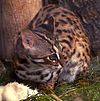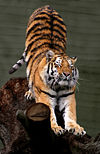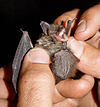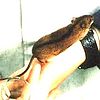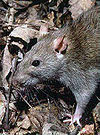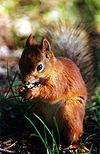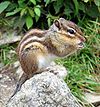- List of mammals of Korea
-
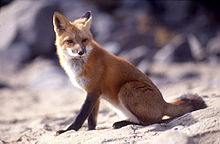 Once common throughout Korea, the Red Fox is now extremely rare.
Once common throughout Korea, the Red Fox is now extremely rare.
This is a list of mammals found in the wild on the Korean Peninsula. Approximately 100 species of mammals are known to inhabit, or recently to have inhabited, the peninsula and its surrounding waters. This includes a few species, such as the Nutria and Muskrat, that were introduced in the 20th century. It also includes other species listed here, such as the Amur Tiger and Japanese Sea Lion, which have probably been extirpated but are still included in standard lists of Korean mammals.
Most of these species are found only in a small part of Korea. The large southeastern island of Jeju, and the rugged northeastern Paektusan region, are particularly known for their distinctive fauna. Several species, including the Dsinezumi Shrew, are found only on Jeju, while many other species such as the Wild Boar are absent or extirpated from there.
The species included in this list are drawn from Won and Smith (1999). Information on the international status of species has been drawn from the IUCN Red List.
Order Artiodactyla: Even-toed Ungulates
Main article: ArtiodactylaCommon name (Korean name)
Species (Authority)
Preferred habitat Range Status[1] Family Bovidae: Bovids Long-tailed Goral Naemorhedus caudatus[2]
(Hamilton Smith, 1827)High mountains. Northern Taebaek Mountains, including the Demilitarized Zone.[3] - I: Vulnerable[4]
- K: Endangered.[5]
- NK: Natural monument.[6]
- SK: Natural monument.[7]
Family Cervidae: Deer Siberian Roe Deer Capreolus pygargus
(Pallas, 1771)Forest verges. Throughout; not found on Ulleungdo. - I: Least Concern[8]
- K: Locally abundant.[9]
Wapiti Cervus canadensis
(Erxleben, 1777)Forest verges. North Hamgyong and the Paektusan region. - I: Least Concern[10]
- K: Rare.[5]
- NK: Natural monument.[11]
Sika Deer Cervus nippon
(Temminck, 1838)Open forests and forest verges. Throughout mainland.[12] - I: Least Concern.[13]
- K: Vulnerable.[5]
- NK: Natural monument.[14]
Water Deer Hydropotes inermis
(Swinhoe, 1870)Low mountains and riparian areas. Throughout mainland. - I: Near Threatened.[15]
- SK: Game.[16]
Family Suidae: Pigs Wild Boar Sus scrofa
(Linnaeus, 1758)Mountain forests. Throughout mainland. - I: Least Concern[17]
- SK: Game[16]
Family Moschidae: Musk deer Siberian Musk Deer Moschus moschiferus
(Linnaeus, 1758)Mountain forests. North Korea; also found in Gangwon, South Korea. - I: Vulnerable.[18]
- K: Endangered.[5]
- NK: Natural monument.[19]
- SK: Natural monument.[20]
Order Carnivora: Carnivores
Main article: CarnivoraCommon name (Korean name)
Species (Authority)
Preferred habitat Range Status[1] Family Canidae: Canids eurasian Wolf Canis lupus
(Linnaeus, 1758)Forests and open woods. Paektusan area. - I: Least Concern.[21]
- K: Endangered.[5][22]
Dhole Cuon alpinus[23]
(Pallas, 1811)Dense forests and high mountains. Paektusan area. - I: Endangered[24]
- K: Vulnerable.[5]
Raccoon Dog Nyctereutes procyonoides
(Gray, 1834)Wooded valleys. Throughout mainland. - I: Least Concern[25]
- K: Uncommon.[26]
Fox Vulpes vulpes
(Linnaeus, 1758)Brushy areas and forest verges. Northern and northeastern Korea. - I: Least Concern[27]
- K: Endangered.[28]
Family Felidae: Felids Leopard Cat Prionailurus bengalensis[29]
(Kerr, 1792)Dense forests. Central and northern Korea. - I: Least Concern.[30]
- K: Vulnerable.[31]
Eurasian Lynx Lynx lynx
(Linnaeus, 1758)Montane forests. North Hamgyong and Chagang, North Korea. - I: Near Threatened.[32]
- K: Endangered.[5]
Amur Leopard Panthera pardus orientalis
(Schlegel, 1857)High dense forests. Northern Korea. - I: Critically Endangered.[33]
- K: Endangered.[5]
Amur Tiger Panthera tigris altaica
(Temminck, 1844)Rocky forests. Hamgyong provinces, northeastern North Korea. Family Mustelidae: Mustelids European Otter Lutra lutra
(Linnaeus, 1758)Riparian areas. Throughout mainland, scattered. - I: Near Threatened.
- K: Endangered.[35]
- NK: Natural monument.[36]
- SK: Natural monument.[37]
Yellow-throated Marten Martes flavigula
(Boddaert, 1785)High forests. Northern Korea. - I: Least Concern.
- K: Vulnerable.[5]
Japanese Marten Martes melampus
(Wagner, 1841)High forests. Central and northern Korea.[31] - I: Least Concern.
- K: Rare.[5]
- NK: Natural monument.[38]
Sable Martes zibellina
(Linnaeus, 1758)High, dense boreal forests. North Hamgyong, northeastern North Korea. - I: Least Concern.
- K: Endangered.[5]
- NK: Natural Monument.[39]
Asian Badger Meles leucurus
(Hodgson, 1847)Forests and mountain valleys. Fossorial. Throughout mainland. - I: Least Concern.
Least Weasel Mustela nivalis
(Linnaeus, 1758)Subalpine areas. Far northeastern and northwestern North Korea.[40] - I: Least Concern.
- K: Rare to locally abundant.[40]
Siberian Weasel Mustela sibirica[41]
(Pallas, 1773)Forests and riparian areas. Throughout, including Jeju.[40] - I: Least Concern.
- K: Locally abundant.[40]
Family Ursidae: Bears Asiatic Black Bear Ursus thibetanus[42]
(G. Cuvier, 1823)Thick forests. Jirisan and Seoraksan in South Korea; Kumgangsan and Paektusan in North Korea. - I: Vulnerable.[43]
- K: Endangered.[5]
- SK: Natural monument.[44]
Brown Bear Ursus arctos
(Linnaeus, 1758)Thick forests. Central and northern Korea. - I: Least concern.[45]
- K: Endangered.[46]
- NK: Natural monument.[47]
Superfamily Pinnipedia: Pinnipeds Common name (Korean name)
Species (Authority)
Preferred habitat Range Status[1][48] Family Otariidae: Eared Seals Northern Fur Seal Callorhinus ursinus
(Linnaeus, 1758)Coasts and seas. Most common in the Sea of Japan. Steller's Sea Lion Eumetopias jubatus
(Schreber, 1776)Coasts and seas. Northern Yellow Sea and Sea of Japan - I: Endangered.[51]
- K: Vulnerable.[5]
California Sea Lion Zalophus japonicus[52]
(Peters, 1866)Rocky coasts. Last seen on Liancourt Rocks in 1951. Family Phocidae: Earless Seals Common Seal Phoca vitulina
(Linnaeus, 1758)Coasts and seas. Northern Sea of Japan. - I: Least Concern.
Spotted Seal Phoca largha
(Pallas, 1811)Coasts and seas. Throughout Yellow Sea, Sea of Japan, and Korea Strait; large colony on Baengnyeongdo. - I: Least Concern.
- K: Vulnerable.[5]
- SK: Natural Monument.[53]
Order Cetacea: Whales
Main article: CetaceaCommon name (Korean name)
Species (Authority)
Preferred habitat Range Status[1] Suborder Mysticeti: Baleen whales Family Balaenopteridae: Rorquals Minke Whale Balaenoptera acutorostrata
(Lacépède, 1804)Widespread. Yellow Sea, East China Sea, Sea of Japan. Blue Whale Balaenoptera musculus
(Linnaeus, 1758)Deep ocean waters. Fin Whale Balaenoptera physalus
(Linnaeus, 1758)Coastal waters. Sea of Japan and Yellow Sea. - I: Endangered.[56]
Family Eschrichtiidae: Gray Whales Gray Whale Eschrichtius robustus
(Lilljeborg, 1861)Migratory through coastal waters. Sea of Japan, Korea Strait. Suborder Odontoceti: Toothed Whales Family Delphinidae: Oceanic dolphins Short-Beaked Common Dolphin Delphinus delphis
(Linnaeus, 1758)Warmer coastal waters. Throughout. - I: Least Concern.
- K: Unknown.[59]
Pacific White-Sided Dolphin Lagenorhynchus obliquidens
(Gill, 1865)Warmer coastal waters. Sea of Japan[60] - I: Least Concern.
Orca Orcinus orca
(Linnaeus, 1758)Coastal waters. Throughout. - I: Conservation Dependent.[61]
- K: Unknown, possibly common.[62]
Family Phocoenidae: Porpoises Dall's Porpoise Phocoenoides dalli
(True, 1885)Colder ocean waters. North of the 35th parallel in the Sea of Japan. - I: Vulnerable.[63]
Harbor Porpoise Phocoena phocoena
(Linnaeus, 1758)Colder ocean waters. Sea of Japan. Finless Porpoise Neophocaena phocaenoides
(Cuvier, 1829)Coastal waters. Yellow Sea, Korea Strait, southern Sea of Japan. - I: Data Deficient.[65]
- K: Caught frequently.[66]
Family Physeteridae: Sperm whales Sperm Whale Physeter macrocephalus
(Linnaeus, 1758)Deep oceans. East China Sea - I: Vulnerable.[67]
Family Ziphiidae: Beaked whales Baird's Beaked Whale Berardius bairdii
(Stejneger, 1883)Open seas. Sea of Japan. Order Erinaceomorpha: Hedgehogs
Main article: ErinaceomorphaCommon name (Korean name)
Species (Authority)
Preferred habitat Range Status[1] Family Erinaceidae: Hedgehogs Amur Hedgehog Erinaceus amurensis
(Schrenk, 1859)Deciduous and mixed forests.[69] Throughout mainland. - I: Least Concern.
- K: Rare.[5]
Order Soricomorpha: Shrews and moles
Main article: SoricomorphaCommon name (Korean name)
Species (Authority)
Preferred habitat Range Status[1] Family Talpidae: Moles Japanese Mole Mogera wogura[70]
(Temminck, 1833)High moist forest. Throughout mainland; not found on Jeju or Ulleungdo - I: Least Concern.
- SK: Vermin.[5]
Family Soricidae: Shrews Dsinezumi Shrew Crocidura dsinezumi
(Temminck, 1842)Damp forests and grasslands. Found only on Jeju.[71] - I: Least Concern.
- K: Uncertain.[71]
Ussuri Shrew Crocidura lasiura
(Dobson, 1890)Widespread. Throughout mainland. - I: Least Concern.
- K: Common.[72]
Lesser Shrew Crocidura suaveolens
(Pallas, 1811)Moist deciduous forests. Throughout, including Ulleungdo.[72] - I: Least Concern.
- K: Common.[72]
Eurasian Water Shrew Neomys fodiens
(Pennant, 1771)Riparian areas and mountain lakes.[72] Northern North Korea.[73] - I: Least Concern.
- K: Rare.[5]
Laxmann's Shrew Sorex caecutiens
(Laxmann, 1788)Rugged mountains. Northern and northeastern North Korea.[74] - I: Least Concern.
- K: Abundant.[72]
Large-Toothed Siberian Shrew Sorex daphaenodon
(Thomas, 1907)Boreal forests and alpine meadows. Paektusan region.[75] - I: Least Concern.
Slender Shrew Sorex gracillimus
(Thomas, 1907)Coniferous forests and alpine regions. Northeastern North Korea.[76] - I: Least Concern.
- K: Common.[77]
Even-Toothed Shrew Sorex isodon
(Turov, 1924)Mountain forests. Baekdudaegan mountains.[78] - I: Least Concern.
Eurasian Least Shrew Sorex minutissimus
(Zimmermann, 1780)Rugged mountains bove 1500 meters.[79] Central and northern Korea.[80] - I: Least Concern.
- K: Rare.[5]
Ussuri Shrew Sorex mirabilis
(Ognev, 1937)Moist ground above 1500 meters.[79] Central and northern Korea. - I: Least Concern.
- K: Rare.[5]
Long-Clawed Shrew Sorex unguiculatus
(Dobson, 1890)High moist areas. Northeastern North Korea.[81] - I: Least Concern.
- K: Locally abundant.[82]
Order Chiroptera:Bats
Main article: BatCommon name (Korean name)
Species (Authority)
Preferred habitat Range Status[1] Family Rhinolophidae: Horseshoe bats Greater Horseshoe Bat Rhinolophus ferrumequinum
(Schreber, 1774)Roosts in caves and abandoned mines. Scattered throughout, including Jeju. - I: Near Threatened.
- K: Abundant.[83]
Family Vespertilionidae: Vesper bats Kobayashi's Bat Eptesicus koyabashii
(Mori, 1928)West central Korea.[84] - I: Data Deficient.[85]
- K: Possibly very rare.[83]
Northern Bat Eptesicus nilssonii
(Keyserling et Blasius, 1839)Found in Gyeonggi, northwestern South Korea, and North Hamgyong, northeastern North Korea. - I: Least Concern.
- K: Locally abundant.[83]
Serotine Bat Eptesicus serotinus
(Schreber, 1774)Roosts in roofs and walls. Most common in northwestern Korea. - I: Least Concern.
- K: Locally abundant.[86]
Savi's Pipistrelle Hypsugo savii[87]
(Bonaparte, 1837)Roosts in caves.[88] Throughout. - I: Least Concern.
- K: Uncommon.[26]
Schreiber's Bat Miniopterus schreibersi
(Kuhl, 1817)Grasslands and forests in summer; caves in winter. Scattered throughout. - I: Least Concern.
- K: Rare.[89]
Little Tube-Nosed Bat Murina aurata
(Milne-Edwards, 1872)Unknown. - I: Near Threatened.[90]
- K: Last recorded in 1959.[89]
Greater Tube-Nosed Bat Murina leucogaster
(Milne-Edwards, 1872)Unknown.[91] - I: Least Concern.
- K: Rare.[89]
Far Eastern Myotis Myotis bombinus[92]
(Thomas, 1906)Hibernates in caves. Throughout, including Jeju. - I: Near Threatened.[93]
- K: Uncommon.[86]
Daubenton's Bat Myotis daubentonii
(Kuhl, 1817)Near water. Throughout, including Jeju. - I: Least Concern.
- K: Uncommon.[86]
Hodgson's Bat Myotis formosus
(Hodgson, 1835)Scattered throughout; not found on Jeju.[94] - I: Least Concern.
- K: Vulnerable.[86]
Fraternal Myotis Myotis frater
(G.M. Allen, 1923)Forests. Northern Korea.[95] - I: Near Threatened.[96]
- K: Very rare.[97]
Ikonnikov's Bat Myotis ikonnikovi
(Ognev, 1912)Scattered throughout, including Jeju. - I: Least Concern.
- K: Very rare.[97]
Big-Footed Myotis Myotis macrodactylus
(Temminck, 1840)Local throughout, including Jeju. - I: Least Concern.
- K: Abundant.[97]
Whiskered Bat Myotis mystacinus
(Kuhl, 1817)Forests. Scattered throughout, including Jeju and Ulleungdo.[98] - I: Least Concern.
Birdlike Noctule Nyctalus aviator
(Thomas, 1911)Scattered throughout. - I: Near Threatened.[99]
- K: Rare.[97]
Java Pipistrelle Pipistrellus javanicus[100]
(Gray, 1838)Scattered throughout. - I: Least Concern.
- K: Common.[26]
Brown Long-Eared Bat Plecotus auritus
(Linnaeus, 1758)High mountains. The Taebaek Mountains and the Paektusan area in northern North Korea. - I: Least Concern.
- K: Vulnerable.[26]
Parti-colored Bat Vespertilio murinus
(Linnaeus, 1758)High forests and grasslands in the summer. North Hamgyong, North Korea. - I: Least Concern.
- K: Very rare.[26]
Asian Parti-colored Bat Vespertilio superans
(Thomas, 1899)West central Korea.[101] - I: Least Concern.
- K: Very rare.[89]
Order Lagomorpha: Lagomorphs
Main article: LagomorphaCommon name (Korean name)
Species (Authority)
Preferred habitat Range Status[1] Family Leporidae: Leporids Korean Hare Lepus coreanus
(Thomas, 1892)Widespread at low altitudes.[102] Throughout mainland.[103] - I: Least Concern.
- K: Common.[103]
- SK: Game.[16]
Manchurian Hare Lepus mandschuricus
(Radde, 1861)High rocky forests. Northern Korea. - I: Least Concern.
- K: Common.[103]
Family Ochotonidae: Pikas Northern Pika Ochotona hyperborea
(Pallas, 1811)Alpine meadows, 1000-2500 m. Northern Korea. - I: Least Concern.
- K: Common.[103]
Order Rodentia: Rodents
Main article: RodentCommon name (Korean name)
Species (Authority)
Preferred habitat Range Status[1] Family Muridae: Murids Striped Field Mouse Apodemus agrarius
(Pallas, 1771)Widespread. Throughout, including Jeju.[104] - I: Least Concern.[105]
- K: Abundant.[104]
Jeju Striped Field Mouse Apodemus chejuensis[106]
(Jones et Johnson, 1965)Widespread. Found only on Jeju. Korean Field Mouse Apodemus peninsulae
(Thomas, 1907)Forest verges and brushland. Throughout mainland. - I: Least Concern.
- K: Common.[104]
Harvest Mouse Micromys minutus
(Pallas, 1771)Low grasslands and fields. Throughout; not found on Ulleungdo. - I: Near Threatened.[107]
- K: Abundant.[104]
House Mouse Mus musculus
(Linnaeus, 1758)Human dwellings. Throughout. - I: Least Concern.
- K: Abundant.[104]
Norway Rat Rattus norvegicus
(Berkenhout, 1769)Urban and cultivated areas. Throughout. - I: Least Concern.
- K: Very abundant.[108]
Black Rat Rattus rattus
(Linnaeus, 1758)Urban areas. Central and southern Korea. - I: Least Concern.
- K: Invasive.[109]
Family Cricetidae: Cricetids Northern Red-Backed Vole Myodes rutilus
(Pallas, 1779)High, dense mixed forest. Far northeastern Korea. - I: Least Concern.[110]
- K: Abundant.[111]
Grey Red-Backed Vole Myodes rufocanus[112]
(Sundevall, 1846)Boreal forest. Northern Korea. - I: Least Concern.[113]
- K: Abundant.[111]
Chinese Striped Hamster Cricetulus barabensis
(Pallas, 1773)Fields. Sinuiju and Cholsan, North Korea. - I: Least Concern.[114]
- K: Uncommon.[115]
Royal Vole Eothenomys regulus
(Thomas, 1907)Widespread; avoids deep forests. Southern, central and northwestern Korea. - I: Least Concern.[116]
- K: Common.[111]
Mandarin Vole Lasiopodomys mandarinus[117]
(Milne-Edwards, 1871)Grassy wetlands. Southwestern Korea. - I: Least Concern.
- K: Rare.[5]
Reed Vole Microtus fortis
(Buchner, 1889)High fields and forest verges. Western and northern Korea. - I: Least Concern.
- K: Locally abundant.[115]
Muskrat Ondatra zibethicus
(Linnaeus, 1766)Marshes and lakes. Tumen River basin, North Korea.[118] - I: Least Concern.
- K: Invasive.[118]
Greater Long-Tailed Hamster Tscherskia triton
(de Winton, 1899)Widespread. Throughout, including Jeju.[115] - I: Least Concern.[119]
- K: Common.[115]
Family Myocastoridae: the Coypu Coypu or Nutria Myocastor coypus
(Molina, 1782)Wetlands. South Korea's Yeongnam region. (Introduced for farming in 1990s) - I: Least Concern.
- K: Invasive.[120]
Family Sciuridae: Squirrels Siberian Flying Squirrel Pteromys volans
(Linnaeus, 1758)Boreal forest. Far northeast and Taebaek Mountains. - I: Near Threatened.[121]
- K: Endangered.[5]
Red Squirrel Sciurus vulgaris
(Linnaeus, 1758)Forests. Throughout mainland.[122] - I: Least Concern.
- SK: Vermin.[5]
Siberian Chipmunk Tamias sibiricus
(Laxmann, 1769)Forests. Inland throughout. - I: Least Concern.
- SK: Vermin.[5]
Family Dipodidae: Jumping mice Long-Tailed Birch Mouse Sicista caudata
(Thomas, 1907)Riparian zones and wetlands. Northeastern Korea.[123] See also
Notes
- ^ a b c d e f g h i The following abbreviations are used:
- I: International. These are sourced from the IUCN Red List.
- K: Korea.
- NK: North Korea.
- SK: South Korea.
- J: Jeju.
- ^ Given as Nemorhaedus goral in Won (2004). The Korean population is generally referred to N. c. raddeanus Heude.
- ^ Won (2004), p. 273; Won & Smith (1999), p. 21. It was once widespread across the Taebaek and Rangrim ranges, but the population had fallen to around 40 by 1990.
- ^ Caprinae Specialist Group (1996). Naemorhedus caudatus ssp. raddeanus. 2006. IUCN Red List of Threatened Species. IUCN 2006. www.iucnredlist.org. Retrieved on 5 October 2006.
- ^ a b c d e f g h i j k l m n o p q r s t u v w x Won & Smith (1999), p. 7.
- ^ The goral of Tanchon is designated North Korean natural monument 293. [1]
- ^ Designated South Korean natural monument #217 on November 20, 1968. "산양". Cultural Heritage Administration website. http://nature.cha.go.kr/cont/natural_v.jsp?nat_id=NM-SK217&nation=S&s_cate_id=S0201&img_num=1. Retrieved 2006-12-01.
- ^ Deer Specialist Group (1996). Capreolus pygargus. 2006. IUCN Red List of Threatened Species. IUCN 2006. www.iucnredlist.org. Retrieved on 5 October 2006.
- ^ Won & Smith (1999), p. 21.
- ^ Deer Specialist Group (1996). Cervus elaphus. 2006. IUCN Red List of Threatened Species. IUCN 2006. www.iucnredlist.org. Retrieved on 1 December 2006.
- ^ The Samjiyon population is designated as natural monument #354."삼지연큰사슴". Cultural Heritage Administration website. http://nature.cha.go.kr/cont/result_v.jsp?nat_id=NM-NK354. Retrieved 2006-12-01.
- ^ Won (2004), p. 264
- ^ Deer Specialist Group (1996). Cervus nippon. 2006. IUCN Red List of Threatened Species. IUCN 2006. www.iucnredlist.org. Retrieved on 1 December 2006.
- ^ The Samjiyon population has been designated Natural Monument 349, and the Paegam population Natural Monument 362. "삼지연사슴". Cultural Heritage Administration website. http://nature.cha.go.kr/cont/natural_v.jsp?nat_id=NM-NK349. Retrieved 2006-12-01.
- ^ Deer Specialist Group (1996). Hydropotes inermis. 2006. IUCN Red List of Threatened Species. IUCN 2006. www.iucnredlist.org. Retrieved on 5 October 2006.
- ^ a b c Won & Smith (1999), p. 7. One of only 3 mammal species legally hunted in South Korea.
- ^ Pigs & Peccaries Specialist Group (1996). Sus scrofa. 2006. IUCN Red List of Threatened Species. IUCN 2006. www.iucnredlist.org. Retrieved on 1 December 2006.
- ^ Deer Specialist Group (1996). Moschus moschiferus. 2006. IUCN Red List of Threatened Species. IUCN 2006. www.iucnredlist.org. Retrieved on 5 October 2006.
- ^ The musk deer of Rogya ri, in Undok, North Hamgyong, has been designated natural monument #331."록야리 사향노루". Cultural Heritage Administration website. http://nature.cha.go.kr/cont/natural_v.jsp?nat_id=NM-NK337&nation=N&s_cate_id=N0202&img_num=7. Retrieved 2006-12-01. The population in the Mayafgdfgsertewrtwrtwertwertwerng workers' district of Musan is designated #380, while the population in Taehung county is designated #401. [2]
- ^ Designated natural monument #216 on October 20, 1968. "사향노루". Cultural Heritage Administration website. http://nature.cha.go.kr/cont/natural_v.jsp?nat_id=NM-SK216&nation=S&s_cate_id=S0201&img_num=1. Retrieved 2006-12-01.
- ^ Wolf Working Group (2004). Canis lupus. 2006. IUCN Red List of Threatened Species. IUCN 2006. www.iucnredlist.org. Retrieved on 2006-12-02.
- ^ Won (2004), p. 147.
- ^ Commonly referred to C. a. alpinus. Won & Smith (1999), p. 16
- ^ Dhole Working Group (2004). Cuon alpinus. 2006. IUCN Red List of Threatened Species. IUCN 2006. www.iucnredlist.org. Retrieved on 2006-10-21.
- ^ Sillero-Zubiri, C. & Hoffmann, M. (2004). Nyctereutes procyonoides. 2006. IUCN Red List of Threatened Species. IUCN 2006. www.iucnredlist.org. Retrieved on 2006-12-02.
- ^ a b c d e Won & Smith (1999), p. 14.
- ^ Macdonald, D.W. & Reynolds, J.C. (2004). Vulpes vulpes. 2006. IUCN Red List of Threatened Species. IUCN 2006. www.iucnredlist.org. Retrieved on 2006-12-02.
- ^ Won (2004, p. 151); Won & Smith (1999), p. 7.
- ^ Given as Felis bengalensis in older sources and in Won (2004).
- ^ Cat Specialist Group (2002). Prionailurus bengalensis. 2006. IUCN Red List of Threatened Species. IUCN 2006. www.iucnredlist.org. Retrieved on 2006-12-02.
- ^ a b Won & Smith (1999), p. 18.
- ^ Cat Specialist Group (2002). Lynx lynx. 2006. IUCN Red List of Threatened Species. IUCN 2006. www.iucnredlist.org. Retrieved on 2006-11-29.
- ^ Cat Specialist Group (1996). Panthera pardus ssp. orientalis. 2006. IUCN Red List of Threatened Species. IUCN 2006. www.iucnredlist.org. Retrieved on 2006-11-29.
- ^ Cat Specialist Group (1996). Panthera tigris ssp. altaica. 2006. IUCN Red List of Threatened Species. IUCN 2006. www.iucnredlist.org. Retrieved on 2006-11-29.
- ^ Designated as such in 1982. Won & Smith 1999, pp. 7, 18.
- ^ The Poptong population is designated Natural Monument #249, and population in Yonsa's Sinyang workers' district is designated #331. "법동수달". 남북한의 천연기념물. http://nature.cha.go.kr/cont/natural_v.jsp?nat_id=NM-NK249. Retrieved 2006-12-06. [3]
- ^ Designated as Natural Monument #330."Natural Monuments No. 330". Cultural Heritage Administration website. http://www.cha.go.kr/english/search_plaza/ECulresult_Db_View.jsp?VdkVgwKey=16,03300000,ZZ&queryText=V_EKDCD='16'&requery=0. Retrieved 2006-10-01.
- ^ The Paegam population is designated Natural Monument #366. "백암누른돈". 남북한의 천연기념물. http://nature.cha.go.kr/cont/result_v.jsp?nat_id=NM-NK366. Retrieved 2006-12-06.
- ^ The Paegam population is designated North Korean Natural Monument #331. "백암검은돈". 남북한의 천연기념물. http://nature.cha.go.kr/cont/result_v.jsp?nat_id=NM-NK331. Retrieved 2006-12-06.
- ^ a b c d Won & Smith (1999), p. 19.
- ^ The variety of M. sibirica found on Jeju Island is sometimes regarded as a separate subspecies, the "Jeju Weasel" or Mustela sibirica quelpartis Thomas 1906.
- ^ Given in many sources as Selenarctos thibetanus.
- ^ Bear Specialist Group (1996). Ursus thibetanus. 2006. IUCN Red List of Threatened Species. IUCN 2006. www.iucnredlist.org. Retrieved on 2006-12-06.
- ^ Designated as South Korean natural monument 329 on November 4, 1982. Cultural Heritage Administration. "Natural Monuments 329". Exploring of Cultural Heritage. http://www.cha.go.kr/english/search_plaza_new/ECulresult_Db_View.jsp?VdkVgwKey=16,03290000,ZZ. Retrieved 2006-12-06.
- ^ Bear Specialist Group (1996). Ursus arctos. 2006. IUCN Red List of Threatened Species. IUCN 2006. www.iucnredlist.org. Retrieved on 2006-12-06.
- ^ Due to heavy hunting. Won & Smith (1999), p. 17.
- ^ The Ryongrim population was designated natural monument #124 on January 1, 1980. "룡림큰곰". 남북한희 천연기념물. http://nature.cha.go.kr/cont/natural_v.jsp?nat_id=NM-NK124&nation=N&s_cate_id=N0202. Retrieved 2006-12-06. The Yonsa population has been designated natural monument #330.[4]
- ^ According to Won (2004, p. 188ff), seals are protected from hunting under South Korean law.
- ^ Seal Specialist Group (1996). Callorhinus ursinus. 2006. IUCN Red List of Threatened Species. IUCN 2006. www.iucnredlist.org. Retrieved on 2006-12-10.
- ^ Pop. estimated at 1.3 million in Won (2004), p. 191.
- ^ Seal Specialist Group (1996). Eumetopias jubatus. 2006. IUCN Red List of Threatened Species. IUCN 2006. www.iucnredlist.org. Retrieved on 2006-12-10.
- ^ Sometimes treated as a subspecies of the California Sea Lion, Zalophus californianus japonicus.
- ^ Designated Natural Monument #331 on November 4, 1982. Won (2004), p. 194.
- ^ Cetacean Specialist Group (1996). Balaenoptera acutorostrata. 2006. IUCN Red List of Threatened Species. IUCN 2006. www.iucnredlist.org. Retrieved on 2006-12-10.
- ^ Cetacean Specialist Group (1996). Balaenoptera musculus ssp. musculus (North Pacific stock). 2006. IUCN Red List of Threatened Species. IUCN 2006. www.iucnredlist.org. Retrieved on 2006-12-10.
- ^ Cetacean Specialist Group (1996). Balaenoptera physalus. 2006. IUCN Red List of Threatened Species. IUCN 2006. www.iucnredlist.org. Retrieved on 2006-12-10.
- ^ Cetacean Specialist Group (1996). Eschrichtius robustus. 2006. IUCN Red List of Threatened Species. IUCN 2006. www.iucnredlist.org. Retrieved on 2006-12-10.
- ^ Its feeding grounds have been designated South Korean natural monument 126.
- ^ Won (2004), p. 244.
- ^ The Sea of Japan population is estimated at 80,000-100,000. Won (2004), p. 245.
- ^ Cetacean Specialist Group (1996). Orcinus orca. 2006. IUCN Red List of Threatened Species. IUCN 2006. www.iucnredlist.org. Retrieved on 2006-12-10.
- ^ Won (2004), p. 238.
- ^ Cetacean Specialist Group (1996). Phocoenoides dalli. 2006. IUCN Red List of Threatened Species. IUCN 2006. www.iucnredlist.org. Retrieved on 2006-12-10.
- ^ Cetacean Specialist Group (1996). Phocoena phocoena. 2006. IUCN Red List of Threatened Species. IUCN 2006. www.iucnredlist.org. Retrieved on 2006-12-10.
- ^ Cetacean Specialist Group (1996). Neophocaena phocaenoides. 2006. IUCN Red List of Threatened Species. IUCN 2006. www.iucnredlist.org. Retrieved on 2006-12-10.
- ^ Nam (2004), p. 254.
- ^ Cetacean Specialist Group (1996). Physeter macrocephalus. 2006. IUCN Red List of Threatened Species. IUCN 2006. www.iucnredlist.org. Retrieved on 2006-12-10.
- ^ Cetacean Specialist Group (1996). Berardius bairdii. 2006. IUCN Red List of Threatened Species. IUCN 2006. www.iucnredlist.org. Retrieved on 2006-12-10.
- ^ Won & Smith (1999), p. 6.
- ^ Sometimes considered two species, Mogera robusta and Mogera wogura.
- ^ a b Formerly common on Jeju, but has not been reported there since the 1970s. Won & Smith (1999), p. 8.
- ^ a b c d e Won & Smith (1999), p. 9.
- ^ There are also unverified reports from Seoraksan in South Korea. Won (2004), p. 29.
- ^ Also reported from Mungyeong, South Korea.
- ^ The first specimen was found there in 2001. Won (2004), p. 31.
- ^ There is also an unconfirmed 1983 report from Jirisan in South Korea. Won (2004), p. 32.
- ^ Won & Smith (1999), p. 10.
- ^ The first specimen was taken on Odaesan in South Korea in 1999. Won (2004), p. 33; cites Han et al. (2000), "New records of two Sorex species (Soricidae) from South Korea", Mammal Study 25:2, 141-144.
- ^ a b Won (2004), p. 34.
- ^ Has been recorded only from Seoraksan and Odaesan. Won & Smith (1999), p. 10.
- ^ May also have been collected from Jirisan, but this has not been confirmed. Won (2004), p. 35.
- ^ Won & Smith (1999), p. 10-11.
- ^ a b c Won & Smith (1999), p. 11.
- ^ Kobayashi's Bat has been reported from Pyongyang, Kaesong, and Seoul, according to Won (2004), p. 85.
- ^ Chiroptera Specialist Group (1996). Eptesicus kobayashii. 2006. IUCN Red List of Threatened Species. IUCN 2006. www.iucnredlist.org. Retrieved on 2006-12-10.
- ^ a b c d Won & Smith (1999), p. 12.
- ^ Often given as Pipistrellus savii, or considered to be a separate species Pipistrellus coreensis. Won (2004), p. 72; Won & Smith (1999), p. 14.
- ^ Won (2004), p. 72.
- ^ a b c d Won & Smith (1999), p. 15.
- ^ Chiroptera Specialist Group (1996). Murina aurata. 2006. IUCN Red List of Threatened Species. IUCN 2006. www.iucnredlist.org. Retrieved on 2006-12-10.
- ^ Won & Smith (1999), p. 15. Won & Smith suggest that its range probably includes east-central and northeastern Korea.
- ^ Formerly considered a subspecies of Myotis nattereri. Won & Smith (1999), p. 12.
- ^ Chiroptera Specialist Group (1996). Myotis bombinus. 2006. IUCN Red List of Threatened Species. IUCN 2006. www.iucnredlist.org. Retrieved on 2006-12-10.
- ^ Won (2004), p. 61.
- ^ Also reported from Masan, South Korea, according to Won (2004), p. 57.
- ^ Chiroptera Specialist Group (1996). Myotis frater. 2006. IUCN Red List of Threatened Species. IUCN 2006. www.iucnredlist.org. Retrieved on 2006-12-10.
- ^ a b c d Won & Smith (1999), p. 13.
- ^ Won (2004), p. 54.
- ^ Chiroptera Specialist Group (1996). Nyctalus aviator. 2006. IUCN Red List of Threatened Species. IUCN 2006. www.iucnredlist.org. Retrieved on 2006-12-10.
- ^ Sometimes considered to belong to Pipistrellus abramus.
- ^ There are records from the provinces of Gyeonggi, South Korea, and South Pyongan, North Korea. However, the only recent record is from Anju in North Korea.
- ^ Seldom seen at elevations above 500 meters, according to Ministry of Environment (2005). "멧토끼" (PDF). 한국고유생물종도감 [Hanguk goyu saengmuljong dogam] [English title: Endemic species of Korea]. p. 6. http://nre.me.go.kr/meweb/data/download/Guide01.pdf.
- ^ a b c d Won & Smith (1999), p. 28.
- ^ a b c d e f Won & Smith (1999), p. 27.
- ^ Amori, G. (1996). Apodemus agrarius. 2006. IUCN Red List of Threatened Species. IUCN 2006. www.iucnredlist.org. Retrieved on 2006-12-07.
- ^ Formerly considered a subspecies of Apodemus agrarius, but shown to be a separate species by mitochondrial studies in the 1990s. Won & Smith (1999), p. 27.
- ^ Amori, G. (1996). Micromys minutus. 2006. IUCN Red List of Threatened Species. IUCN 2006. www.iucnredlist.org. Retrieved on 2006-12-10.
- ^ Possibly the most abundant mammal on the Korean Peninsula, according to Won & Smith (1999), p. 28.
- ^ Introduced accidentally, according to Won & Smith (1999), p. 28.
- ^ Amori, G. (1996). Clethrionomys rutilus. 2006. IUCN Red List of Threatened Species. IUCN 2006. www.iucnredlist.org. Retrieved on 2006-12-07.
- ^ a b c Won & Smith (1999), p. 25.
- ^ Sometimes given as Clethrionomys rufocanus
- ^ Amori, G. (1996). Clethrionomys rufocanus. 2006. IUCN Red List of Threatened Species. IUCN 2006. www.iucnredlist.org. Retrieved on 2006-12-07.
- ^ Baillie, J. (1996). Clethrionomys rutilus. 2006. IUCN Red List of Threatened Species. IUCN 2006. www.iucnredlist.org. Retrieved on 2006-12-07.
- ^ a b c d Won & Smith (1999), p. 26.
- ^ Baillie, J. (1996). Eothenomys regulus. 2006. IUCN Red List of Threatened Species. IUCN 2006. www.iucnredlist.org. Retrieved on 2006-12-07.
- ^ Sometimes called Microtus mandarinus.
- ^ a b The Muskrat was first recorded in the Tumen River basin in 1965; according to Won & Smith (1999), it had been introduced several decades earlier into the Russian Far East, and may have been present in Korea for some time before the first report.
- ^ Baillie, J. (1996). Tscherskia triton. 2006. IUCN Red List of Threatened Species. IUCN 2006. www.iucnredlist.org. Retrieved on 2006-12-10.
- ^ Won (2004), p. 141.
- ^ Amori, G. (1996). Pteromys volans. 2006. IUCN Red List of Threatened Species. IUCN 2006. www.iucnredlist.org. Retrieved on 2006-12-13.
- ^ Won (2004), p. 107.
- ^ Specimens have been collected from Pujŏn in South Hamgyong and Samjiyŏn in Ryanggang. Won (2004), p. 116. In addition, Smith & Won (1999) report it from Yanggang in Gangwon, South Korea.
- ^ Tchabovsky, A. (1996). Sicista caudata. 2006. IUCN Red List of Threatened Species. IUCN 2006. www.iucnredlist.org. Retrieved on 2006-10-05.
References and further reading
- Han Sang-hun (한상훈) (1998). "사라져가는 한국의 야생 포유동물 [Sarajyeoganeun han-guk-ui yasaeng poyudongmul / Korea's vanishing wild mammals"]. http://my.dreamwiz.com/environment/html/ham2/2-13.htm. Retrieved 2006-09-29.
- Won, Pyong-Hooi (원병희) (1967). 한국동식물도감, 7권: 포유류 [Han-guk dongsingmul dogam 7gwon: poyuryu / Guide to Korea's plants and animals, vol. 7: Mammalia]. Seoul: Ministry of Culture and Education. http://www.wildlife.re.kr/mammal/mammal-1967.htm.
- Won, Byeong-o (원병오) (2004). 한국의 포유동물 [Hangugui poyudongmul] [English title: The Mammals of Korea]. Seoul: Dongbang Media. ISBN 89-8457-310-8.
- Won, Changman; Kimberly G. Smith (1999). "History and current status of mammals of the Korean Peninsula". Mammal Review (Mammal Society) 29 (1): 3–36. doi:10.1046/j.1365-2907.1999.00034.x.
Categories:- Korea-related lists
- Lists of mammals by location
- Fauna of Korea
Wikimedia Foundation. 2010.












